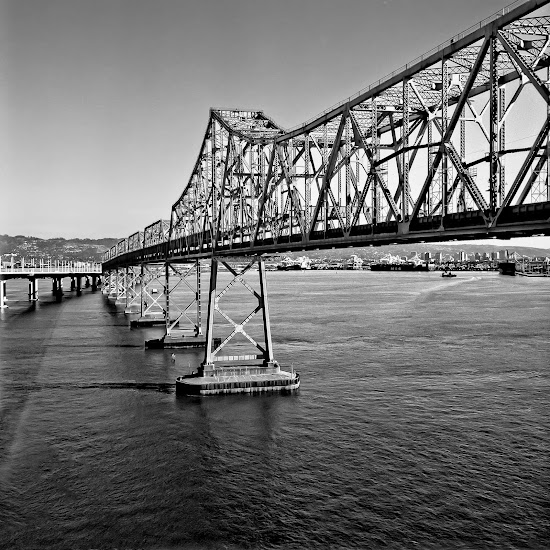The Bridge
Huddled in the bow, we are the only passengers for the short voyage across the bay. With a long blast of its whistle, the wooden car ferry backs away from the dock. The engine throbs, leaving a churning, foamy wake trailing from the stern. The air is heavy with the smell of fish and salt. Gulls circle overhead.
“This is our last chance to ride the ferry,” explains my father wistfully. “With the Bay Bridge finished, it’s now faster to drive.”
Both of my parents had attended Cal. And their daily commute by ferry - from San Francisco Chinatown to Berkeley and back - was a trip that they had made countless times during their college years. During the war years. Back when Japanese classmates had been forced to abandon their studies and board buses bound for distant internment camps.
But today belongs to the Bay Bridge – that critical but unglamorous link in the freeway system that carries us swiftly over the swirling, dark waters far below. The bridge toll is only $.25 (“Two bits!” my dad calls out, as he offers a well-worn, Washington-head quarter to the toll-takers – all men). Gas stations are full-service. And for $2.00, a smiling attendant, dressed in a cap and starched uniform, fills our tank with gas, washes the windshield, checks the oil and puts air in all four tires.
The top deck is for cars, and the lower deck for trucks and trains. But eventually, the cars win out. The train tracks are removed. And the top deck is converted to traffic going into the City, with the lower deck reserved for cars traveling eastward to Oakland and Berkeley.
From our home in the east bay hills, the trip into the City is a special treat. The long slow climb up the incline section. The passage through the cantilevered cage. The streaming, yellow lights of the Yerba Buena tunnel. The hypnotic rise and fall of the suspension cables. The circling searchlight atop of Alcatraz. The Vegas-style, "Sherwin Williams Paints the World" billboard with its sparkling flashbulbs and neon fireworks. Then, magically! . . . San Francisco. Perched on top of her famous hills.
The weather is particularly fine as I stroll along the walkway that adjoins the gleaming new suspension span. The path is empty except for a few cyclists, the occasional tourist and a few other retirees taking in the fresh marine air.
The cantilevered section of the old Bay Bridge is now closed and off limits to the public. A demolition crew works quickly to disassemble it. By the end of next year, it will be gone.
I peer downward into the viewfinder of my box camera, and an image of the old bridge fills the darkened screen. It is clearly a product of an industrial age. All rivets and bolts. Slabs of steel cut in angular shapes. Heavy, solid and stiff. A giant erector set with millions of steel pieces carefully fitted together. "Like those tough, depression-era iron workers who built it," I muse.
But close observation reveals the engineers’ fears - that it is dangerously ill designed to survive a large, rolling earthquake. A sudden heave of the San Andreas Fault could reduce it to a pile of twisted metal with many lives lost. So a graceful, modern span has been built in its stead. It is time for the old bridge to come down.
Leaning against the nearby guardrail, an old man cradles the hand of his grandchild while gazing at the skeleton of the old bridge. "Last chance to see it before they take it down," he intones. "Now that the new bridge is open, it's a much safer way to cross the bay.” I detect a slight catch in his voice, as I watch a single gull floating high above, on the freshening breeze.



















Comments
He writes about “The Bridge”:
"It's interesting that the idea started as a photo assignment, and that only after I saw the images, that I felt inspired to write the essay.
But once the essay was written, I somehow felt that it is the more important work. In my book, I place the entire essay in the front. And all the photos follow.
When one reads the essay first without the photos, the reader is forced to see the bridge, the people, the relationships - all in the mind's eye. To savor the words. To hear and smell the bridge and its surroundings. To imagine its presence.
Then, only after reading the essay, can the reader look at actual photos. And compare his or her imagined images to "real" ones. I think this is an important part of the journey."
Hearing from you three - Bob, Karina, Alex, all my elders - about ancestors and references to immigration and old world stories, I feel connected to that longer history of this place. It humbles me to know how new I and so many others are here.